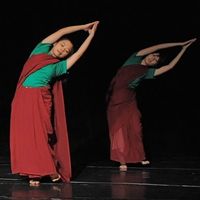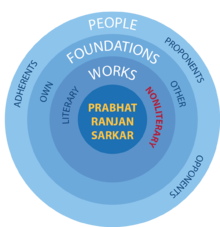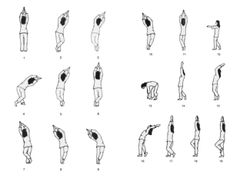Kaosikii nrtya: Difference between revisions
m (Added sections) |
m (Text replacement - "|og:image=" to "|image=") |
||
| (28 intermediate revisions by the same user not shown) | |||
| Line 1: | Line 1: | ||
{{ | {{#seo: | ||
|keywords=Prabhat Ranjan Sarkar,Anandamurti,Ananda Marga,Dance,Women,Kaosikii | |||
|description=Dance invented by Prabhat Ranjan Sarkar primarily for women | |||
|image=https://sarkarverse.org/200fb/200px_Kaosikii.png | |||
|image_width=200 | |||
|image_height=200 | |||
}} | |||
{{Infobox Nonliterary Works | {{Infobox Nonliterary Works | ||
| image = [[File: | | image = [[File:KaosikiiDance.jpg||200px]] | ||
| image_size = | | image_size = | ||
| alt = | | alt = | ||
| Line 14: | Line 20: | ||
| website = | | website = | ||
}} | }} | ||
'''Kaośikii nrtya''' (or, simply, Kaośikii) is a dance invented on September 6, 1978 by the [[:wikipedia:India|India]]n [[:wikipedia:Philosophy|philosopher]] and social reformer [[Prabhat Ranjan Sarkar]], aka Shrii Shrii Anandamurti (1921–1990). | |||
== Purpose == | == Purpose == | ||
Sarkar | Sarkar states that he invented Kaośikii dance primarily with women in mind, as the [[Tandava]] dance given by [[Shiva]] tends to be unwholesome for them. However, Sarkar makes clear that Kaosikii is not just beneficial women but also for men.<ref>Anandamurti, Shrii Shrii (1984). "Táńd́ava and Kaośikii" published in ''Ananda Vacanamrtam Part 22'' [[Ananda Marga Publications]].</ref> | ||
According to Sarkar, Kaosikii has 22 benefits:<ref>Anandamurti, Shrii Shrii (1978). "The Dance of the Expansion of Mind – Excerpt A" published in ''The Awakening of Women (a compilation)'' [[Ananda Marga Publications]].</ref>{{colbegin}} | |||
[[ | # It exercises all the glands and limbs from head to foot. | ||
# It increases longevity. | |||
# It makes for easy delivery. | |||
# The spine will become flexible. | |||
# Arthritis of the spine, neck, waist and other joints will be removed. | |||
# Gout in the spine, neck, hands and waist will be lost. | |||
# The mind becomes strong and sharp. | |||
# Irregularities in menstruation will be cured. | |||
# Glandular secretions will become regulated. | |||
# Troubles in the bladder and urethra will be cured. | |||
# It gives control over the limbs. | |||
# It adds charm and shine to the face and skin. | |||
# It removes wrinkles. | |||
# It removes lethargy. | |||
# It cures insomnia. | |||
# It cures hysteria. | |||
# Fear complexes will be removed. | |||
# Hopelessness will be lost. | |||
# It helps in self-expression and develops one’s potentiality. | |||
# Spinal pain, piles, hernia, hydrocele in men, nervous pain, nervous disability will be cured. | |||
# It cures kidney and gall bladder troubles, gastric trouble, dyspepsia, acidity, dysentery, syphilis, gonorrhoea, obesity, thinness and liver diseases.<br /> | |||
# It increases the capacity to work until 75-80 years of age.{{colend}} | |||
== | == Performance == | ||
[[File:Kaosikii.jpg||right|240px]] | |||
Kaosikii is performed in 18 steps that follow from the initial, ready position. In the ready position, the dancer's hands are together and raised over the head. To the rhythmic beat of "dhin, dhin,... ,tá, tá", which is later replaced by variations on the mantra "Baba Nam Kevalam", the dancer begins swaying the arms and torso as the feet move in place, respectively behind each other. First the forefoot of the right foot goes behind the heel of the left foot, and then vice versa. At the same time, the upper body sways to the right, (30, 60, and then 90 degrees down, followed by 45 and then 90 degrees up). The same thing is done with the upper body swaying to the left to the left. Then the upper body sways forward (90 and then 180 degrees down, followed by 180 degrees up), and finally backward (45 and then 90 degrees back, followed by 90% up). These light steps are all referred to as ''dhin''. In the final two steps, the dancer stamps firmly on the ground (''tá'' ''tá''), first with the right foot and then with the left. Immediately thereafter, the next round of 18 steps begins. There is no limit to the number of rounds that a Kaoshikii dancer may perform. The dance ends where it began, in the ready position. | |||
== Ideation == | |||
Sarkar explains the ideation to be maintained while performing Kaosikii as follows: | |||
{{quote|''The two hands upraised and folded together represent, "Now I am trying to establish a link with Parama Puruśa." Both hands bending to the right indicate, "I know the right way to request You." The bending of the body should be at a 45-degree angular projection. The leftward movement represents, "I know how to fulfill Your demands." The movement of bending in front suggests complete surrender. The backward bending represents, "I am ready to face all troubles that may come." The last tá, tá represents, "O Lord, I repeat Your rhythm."''<ref>Anandamurti, Shrii Shrii (1979). "Dances and the Path of Vidyá" published in ''Ananda Vacanamrtam Part 12''. [[Ananda Marga Publications]].</ref>}} | |||
== | == See also == | ||
* [[Lalita marmika|Lalita mármika]] | |||
* [[Tandava|Táńd́ava]] | |||
== | == References == | ||
{{reflist}} | {{reflist}} | ||
[[Category:Works of Prabhat Ranjan Sarkar]] | [[Category:Works of Prabhat Ranjan Sarkar]] | ||
[[Category:Ananda Marga dances]] | |||
Latest revision as of 01:58, 23 April 2021
| Kaosikii nrtya | |
|---|---|
 | |
| Location in Sarkarverse | |
Kaośikii nrtya (or, simply, Kaośikii) is a dance invented on September 6, 1978 by the Indian philosopher and social reformer Prabhat Ranjan Sarkar, aka Shrii Shrii Anandamurti (1921–1990).
Purpose
Sarkar states that he invented Kaośikii dance primarily with women in mind, as the Tandava dance given by Shiva tends to be unwholesome for them. However, Sarkar makes clear that Kaosikii is not just beneficial women but also for men.[1]
According to Sarkar, Kaosikii has 22 benefits:[2]
- It exercises all the glands and limbs from head to foot.
- It increases longevity.
- It makes for easy delivery.
- The spine will become flexible.
- Arthritis of the spine, neck, waist and other joints will be removed.
- Gout in the spine, neck, hands and waist will be lost.
- The mind becomes strong and sharp.
- Irregularities in menstruation will be cured.
- Glandular secretions will become regulated.
- Troubles in the bladder and urethra will be cured.
- It gives control over the limbs.
- It adds charm and shine to the face and skin.
- It removes wrinkles.
- It removes lethargy.
- It cures insomnia.
- It cures hysteria.
- Fear complexes will be removed.
- Hopelessness will be lost.
- It helps in self-expression and develops one’s potentiality.
- Spinal pain, piles, hernia, hydrocele in men, nervous pain, nervous disability will be cured.
- It cures kidney and gall bladder troubles, gastric trouble, dyspepsia, acidity, dysentery, syphilis, gonorrhoea, obesity, thinness and liver diseases.
- It increases the capacity to work until 75-80 years of age.
Performance
Kaosikii is performed in 18 steps that follow from the initial, ready position. In the ready position, the dancer's hands are together and raised over the head. To the rhythmic beat of "dhin, dhin,... ,tá, tá", which is later replaced by variations on the mantra "Baba Nam Kevalam", the dancer begins swaying the arms and torso as the feet move in place, respectively behind each other. First the forefoot of the right foot goes behind the heel of the left foot, and then vice versa. At the same time, the upper body sways to the right, (30, 60, and then 90 degrees down, followed by 45 and then 90 degrees up). The same thing is done with the upper body swaying to the left to the left. Then the upper body sways forward (90 and then 180 degrees down, followed by 180 degrees up), and finally backward (45 and then 90 degrees back, followed by 90% up). These light steps are all referred to as dhin. In the final two steps, the dancer stamps firmly on the ground (tá tá), first with the right foot and then with the left. Immediately thereafter, the next round of 18 steps begins. There is no limit to the number of rounds that a Kaoshikii dancer may perform. The dance ends where it began, in the ready position.
Ideation
Sarkar explains the ideation to be maintained while performing Kaosikii as follows:
The two hands upraised and folded together represent, "Now I am trying to establish a link with Parama Puruśa." Both hands bending to the right indicate, "I know the right way to request You." The bending of the body should be at a 45-degree angular projection. The leftward movement represents, "I know how to fulfill Your demands." The movement of bending in front suggests complete surrender. The backward bending represents, "I am ready to face all troubles that may come." The last tá, tá represents, "O Lord, I repeat Your rhythm."[3]
See also
References
- ^ Anandamurti, Shrii Shrii (1984). "Táńd́ava and Kaośikii" published in Ananda Vacanamrtam Part 22 Ananda Marga Publications.
- ^ Anandamurti, Shrii Shrii (1978). "The Dance of the Expansion of Mind – Excerpt A" published in The Awakening of Women (a compilation) Ananda Marga Publications.
- ^ Anandamurti, Shrii Shrii (1979). "Dances and the Path of Vidyá" published in Ananda Vacanamrtam Part 12. Ananda Marga Publications.

